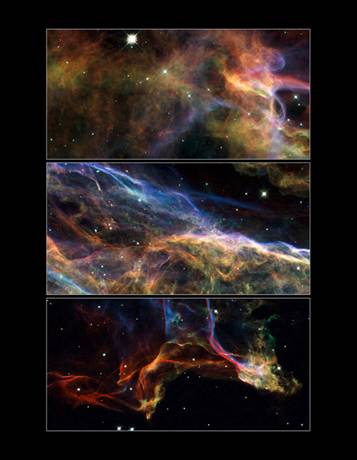06 August 2007

Credit: NASA, ESA, and the Hubble Heritage (STScI/AURA)-ESA/Hubble Collaboration
NASA's Hubble Space Telescope (HST) imaged three portions of the Veil Nebula, the shattered remains of a massive star that exploded thousands of years ago. This series of images provides superbly detailed views of the delicate, wispy structure resulting from this cosmic explosion. The Veil Nebula is one of the most spectacular supernova (exploding star) remnants in the sky. The entire cloud spans about 3° on the sky, corresponding to about 6 full-moon breadths.
The Veil Nebula is a middle-aged supernova remnant, and is a natural laboratory for studying the physics of supernova remnants because of its clear location in our Galaxy, its relative nearness, and its large size. The Veil Nebula is about 1,500 light years away, and is visible in the direction of the constellation Cygnus, the Swan. It is also known as the Cygnus Loop.
The duration of a star's lifetime depends on its mass, which determines the rate at which the star consumes its nuclear fuel. The most massive stars have the shortest lifetimes. When a massive star exhausts its core fuel, it collapses under its own gravity, and catastrophically explodes as a supernova. A supernova releases so much light that it can outshine an entire galaxy. The remains of the exploding star form a glowing, brightly colored shell of gas, termed a "supernova remnant".
Supernova remnants are long-lasting nebulae. Astronomers estimate that the supernova that generated the Veil Nebula exploded 5,000 to 10,000 years ago.
Hubble images provide fascinating close-ups of the Veil. Smoke-like wisps of gas are all that remain visible of the progenitor star. The intertwined rope-like filaments of gas in the Veil Nebula result from the tremendous energy unleashed as the rushing debris from the explosion plows into its surroundings and creates shock fronts. These shocks, driven by debris moving at 600,000 km per hour, heat the gas to searing temperatures of millions of degrees. The subsequent cooling of this material leads to the emission of the brilliant glowing colors.
Supernovae are responsible for synthesizing all chemical elements heavier than iron, as well as being the main sources of oxygen in the Universe. Elements, such as copper, mercury, gold, and lead are synthesized in these cataclysmic events. The expanding shells of supernova remnants mix with other clouds in the Galaxy and become the raw material for the formation of new stars and planets. The chemical elements that make up Earth, and certainly those of which our bodies are made, are believed to have formed deep within the cores of ancient supernovae.
The images were taken with HST's Wide Field Planetary Camera 2 (WFPC2) in November 1994 and August 1997. The color is created by combining three different images. The colors indicate emission from different atoms excited by the shock: blue is due to oxygen, green shows sulfur, and red is emitted by hydrogen.
Further Reading
The Hubble Heritage Project
http://heritage.stsci.edu/2007/30/index.html
Hubble Pictures Cosmic Fireworks in a Dwarf Galaxy
../home/NewsDetail.aspx?Find=fTZJxKN91sPh%2bhW5YuM3pg%3d%3d
Aymen Mohamed Ibrahem
Senior Astronomy Specialist